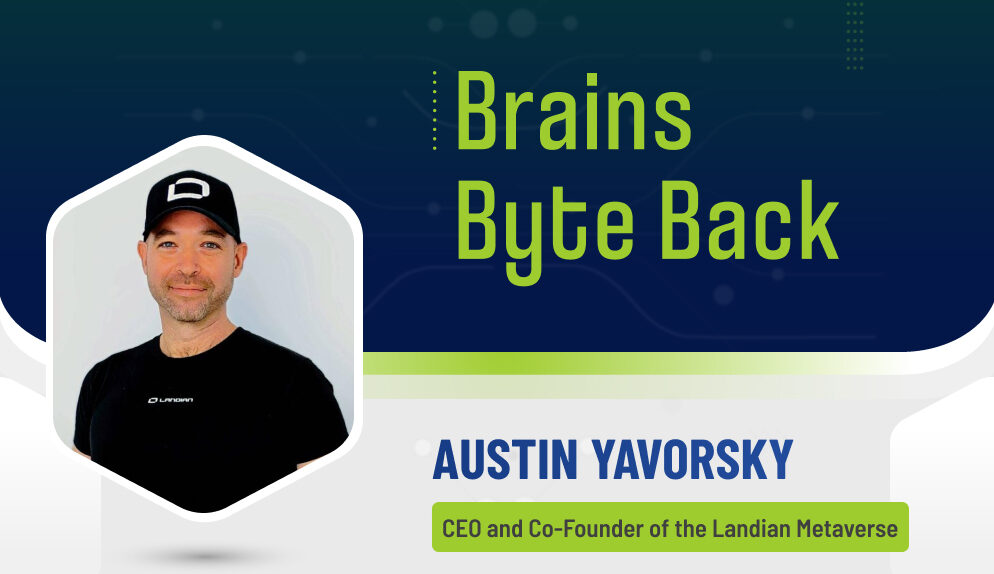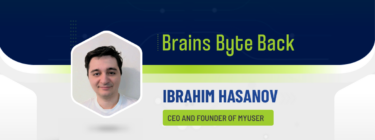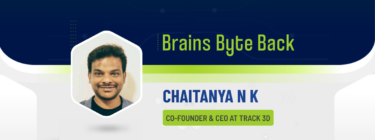In today’s episode of the Brains Byte Back podcast, we speak with Austin Yavorsky, CEO and Co-Founder of the Landian Metaverse, a decentralized metaverse creating spaces for the community to experience a new level of immersive encounters.
Yavorsky starts by sharing that he has been in the crypto space for a very long time. He originally started one of the first exchanges in the world back at the end of 2011 in Central America.
From there he went on to create a variety of interesting blockchain products, starting originally in environmental protection associated with storing data on the Ethereum Blockchain.
He then shares how he moved over to Europe and worked on legislative review and assistance with some of the new crypto laws that were being written at the time in 2015 and 2016. As well as some of the Know Your Customer (KYC) and Anti-Money Laundering (AML) protocols that were originally developed for exchanges.
Yavorsky then jumps forward to share how Landian first began and why they decided on this name for the company. He goes on to discuss some of the work the company is focusing on today.
This leads him to share how Landian is working with a forward-thinking healthcare group to help patients with Post Traumatic Stress Disorder (PTSD) by allowing them to relive some of their trauma in a VR environment.
He discusses how this work was carried out, and the promising results that have come from it, stating that many of the participants went from taking between five to seven different types of antidepressants, all the way down to just a handful or none after a relatively short period of time.
And finally, Yavorsky talks about what else excites him the most about the Metaverse, and what’s next on the horizon for Landian.
You can listen to the episode below, or on Spotify, Anchor, Apple Podcasts, Breaker, Google Podcasts, Stitcher, Overcast, Listen Notes, PodBean, and Radio Public.
Alternatively, you can find a transcript below:
Austin Yavorsky: Thanks, Sam. My name is Austin Yavorsky. I’m the CEO of the Landian, Metaverse. We were founded in 2019. We currently have about 250 employees here in Medellin, Colombia with offices in Dubai and Madrid as well.
Austin Yavorsky: I myself have been in the crypto space for a very long time. So I started one of the first exchanges in the world back at the end of 2011, the beginning of 2012, in Central America. And from there went on to do a lot of really interesting blockchain products. Starting originally in environmental protection associated with storing, very interesting data on the Ethereum Blockchain at the beginning. And then ended up moving over to Europe and continuing a lot of that work afterward as well as doing a lot of legislative review and assistance with some of the new crypto laws that were being written at the time which is about 2015-2016 as well as some of the sort of the AML and KYC protocols that were originally developed for exchanges as all. So, myself and my partners have been at it for quite some time. I found some of the pitfalls associated with some of the other metaverses out there and decided to try and fix it.
Samuel Brake Guia: Fantastic. Well, thank you for joining me today. I’m super excited about this and it sounds like you really have quite an extensive history in this space. I’d love to know when and how did Landian first start?
Austin Yavorsky: Yeah. So Landian was born as an idea and 2018 give or take, I personally did a bit of advisory work for some of the early Metaverses. I was a consultant for Decentraland and they’re gaming Division, Vegas City when that was originally launched. And I had seen a lot of the issues that they were having with the speed of the Ethereum Blockchain, as well, as some of the graphics hindrances that were built around the issues related to some of the NFTs and running on IPFS. So, we decided that we were going to take a deep dive to try and see. Not only how we can make a better metaverse, but effectively one that was actually useful and a lot of the early things that had happened back around that period of time. It was very, you know experimental. There were some interesting things going on around the concepts, but we had never really seen a proper use case where either someone would spend A a considerable amount of time in the Metaverse, or B, they would use it for something other than speculative investments. So, we set out to effectively create something that was functional and usable. That you could spend a decent amount of time in and that, both individuals and businesses would find benefits of either adding it to their existing, sort of repertoire of tools that they had or complementing, some of the other things that were out there.
Samuel Brake Guia: Fantastic. Well, it definitely sounds like there was a genuine need for this and I’m really curious to know like why the name Landian?
Austin Yavorsky: Yeah, we had researched a bunch of different ones, but we wanted it to feel like a place for everyone was a member and everyone represented the space itself. And at the end of the day, you know, we’re all humans. We all live in one particular place and we decided to try and give it something that seemed familiar. But also felt like it was part of a whole.
Samuel Brake Guia: Yeah, I get the idea of land and I don’t know. Metaverse, I like the name. It’s a good choice of name and I also want to change the subjects slightly like, because I understand that you do a lot of work in the healthcare space and a few years ago, a very forward-thinking healthcare group approach you to see if you and your team could help some of their patients with post-traumatic stress disorder by allowing them to relive some of their trauma in VR. And now, I personally find this really interesting with a background in psychology myself. Can you share how this work was carried out? What are some of the results that have come from it?
Austin Yavorsky: For sure. So we have a lot of different clients, you know, in general, we do things for governments for militaries for healthcare or educational institutions universities. You name it. So a lot of the opportunity with most of the clients really just plums at the discretion of them, trying to understand how they can leverage the Metaverse and use it for different things. So, we’ve been working a lot in the healthcare and wellness space. Originally, we had a couple of customers that were working with us, to try and create some sort of meditation, guided meditation simulations, and things of that nature where we were trying to effectively put people into better states of consciousness. Whether it be for very short periods of time throughout the day to try and increase their over mental overall, mental wellness, or if they were going to use it for a therapeutic. And throughout that process, we’re actually approached by a couple of different groups to do a series of experiments. And one of the most interesting ones is the one you mentioned, which was talking to people that had PTSD and seeing how the Metaverse VR environments as a whole could effectively help them either cope with the trauma or slowly relive it in a way that was amicable without causing too much stress. So it was quite interesting about that, was that in the beginning, I personally wasn’t entirely sure what was going to happen, and I was actually a little bit afraid that there were going to be too many instances of trauma by creating some of these environments. And you have to keep in mind, a lot of these patients, or war veterans, you know, some of them have dealt with things like sexual abuse, so on and so forth. So, some of these, some of these environments are pretty extreme in terms of what actually happens. So the ultimate outcome for us was really overall and just absolutely incredible.
Austin Yavorsky: A lot of these people went to went from taking five, six, seven different types of antidepressants and things like that all the way down to just a handful or none after a relatively short period of time. So it was conducted in 60-day, 120-day, and one-year markers with reliving each of those. And throughout that process, we did a lot of interesting things. So we were mom sharing biometric responses everything from people dilation to you know heart rate to blood pressure. At one point, there was a EKG hooked up to one of the patients and we went through that entire experience and it was really really stunning. But for me, it was just an example of how VR environments can be used for good and just out-of-the-box thinking in general to try and come up with solutions that otherwise wouldn’t be possible in the physical world.
Samuel Brake Guia: That’s a fascinating result. And it’s funny because when I first found out about this work that you did, that was my initial reaction, I was like, Oh my word, that must be so stressful to be put back into that kind of environment. So I was so curious to know how that turned out and it’s fantastic to hear that it is had such a positive impact and kind of on that note over positive impacts in a way. I suppose, I really want to know what else excites you the most when it comes to the Metaverse?
Austin Yavorsky: Yeah. So I really like a lot of the work that we do and health care and wellness because you get do get to see results relatively fast studies like the one that I was just talking about where we’re doing, things like that. That right now with different countries where they’re also implementing things like psychedelics and psilocybin. So and so forth to try and helps feed those processes along. So, there’s a bit of a combination of different tools that are being used, which I think is very useful. I like a lot of the work that we do in muscle memory training, so this is anything from sports to military simulations. So you get to train people, hundreds, if not thousands of times, you know, how to do something. That could either be incredibly important for their career or a life-for-death situation. So you get to sort of have people live that experience over and over and over again before they actually have to do it for real. But I think the thing that excites me the most is the work that we do for overall extended learning and universities in general. So this is everything from remote education all the way down to customer service, training, extended corporate training so on and so forth. And the reason that that excites me is because the Metaverse and those training simulations, have shown time and time again that people are not only absorbing, but they’re retaining a lot more knowledge than they would in classroom environments. I think the bulk of the reason there is because they’re ultra-focused on what happens within that space while they’re doing it. So I think that’s quite important. But in general opening up the world of education to the world without any boundaries associated with distance costs associated with anything and a lot of the different knowledge that can be shared amongst those communities. That is really, really exciting because we get to use these tools as sort of the next generation of learning with the expansion of the Internet and open it up to the entire world, all at once. So, we’re quite excited about it.
Samuel Brake Guia: It is definitely something to be excited about. I think this is such an interesting technology to use for training purposes. I recently had a conversation with a surgeon that was telling me about how VR can help with their training. But otherwise, what is next on the horizon for Landian?
Austin Yavorsky: Yeah, so you know, we get bigger every day. We have our own internal team that works directly with our clients but Landian is being built as a platform. So ultimately the work that we’re doing, these are effectively. You know, we call them here a projects and very large-scale use cases of what can and can’t be done within that space. So the thing that’s next for us is really opening up these tools to the entire world and giving people their own ability to either build whatever, they’d like, work with different clients work on different solutions, for everyday problems, that you otherwise would have issues doing in a physical world. And what we’re really, you know, looking forward to over the next year. So is getting that community engaged, providing them with all the things that they need to do to work that they want to do and I’m excited to see what they build because you know, your imagination is unbounded inside of these spaces and as soon as we give everyone the tools to go out and conquer. We don’t know what we’re going to see. So we’re really, really looking forward to seeing what the community brings to us, as opposed to us bringing it to the community.
Samuel Brake Guia: Well, it’s certainly very exciting, to say the least and I think you got some great things lined up there. And if people do want to keep up with the work that you’re doing, or get involved, even what is the best way for them to do that Austin?
Austin Yavorsky: They can find us online at landian.io, we have Telegram channels. We have Twitter spaces, and so on and so forth. So your standard channels but landian.io is where you can find the bulk of our work.
Samuel Brake Guia: Excellent, once again, thank you so much for joining me today.












